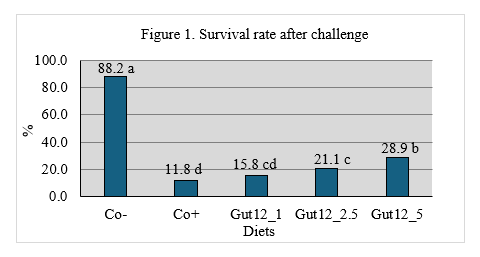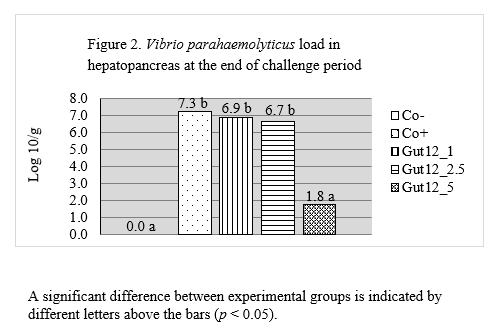IMMUNOMODULATORY EFFECT OF A DIETARY SUPPLEMENT IN WHITELEG SHRIMP Litopenaeus vannamei CHALLENGED WITH Vibrio parahaemolyticus
Introduction
Whiteleg shrimp (Litopenaeus vannamei ) have experienced rising production over the past decade, but intensified farming has led to increased susceptibility to diseases such as acute hepatopancreatic necrosis disease (AHPND). This , caused by Vibrio parahaemolyticus (VP), severely impacts the hepatopancreas (HP) , a key organ for metabolism and immunity . This infection can be detected through the dissection of shrimp HP, where typical signs include a pale appearance and organ atrophy. Due to the economic losses caused by AHPND for shrimp farmers, the use of antibiotics to prevent and treat this infection is common in developing countries. However, the misuse of antibiotics has caused microbial resistance, which poses a significant global threat by reducing the effectiveness of disease treatments. To combat this, alternatives to antibiotics have been explored in shrimp such as essential oils , mannanoligosaccharides and β-glucan, which strengthen shrimp immunity. Additionally, glycerol fatty acid esters have shown antimicrobial properties against Vibrio pathogens. The aim of this study was to evaluate whether a combination of dietary immunomodulators (Marfeed Gut12) can improve the immune resistance of whiteleg shrimp against VP and at which dosage.
Materials and Methods
In a four-replicate setup, five treatments were investigated , including two control groups and three test groups with 30 shrimp ( average initial weight of 1.53 ± 0.07 g) per replicate. The controls included an unchallenged negative control (Co-) and a positive control (Co+) challenged with AHPND. The test groups were also challenged and fed a diet supplemented with test product at dosages of 1.0 (Gut12_1), 2.5 (Gut12_2.5), and 5.0 (Gut12_5) g/kg Marfeed Gut12 . The 27-day trial comprised a 2-day acclimation period, 14 days of pre-challenge feeding, a 1-day VP challenge, and a 10-day post-challenge observation phase. The challenge was conducted via immersion in water by an LD50-60/96-120 h dose of VPAHPND for all diets, excluding the negative control group. Shrimp survival rates were assessed post-challenge eight times per day . At the end of the challenge, qPCR was used to measure VP quantities in the HP, with samples taken from three shrimp per tank. Data analysis through one-way ANOVA revealed statistically significant differences between mean values at p < 0.05.
Results
The findings suggest that dietary supplementation of Marfeed Gut12 significantly enhanced shrimp survival rates in groups challenged with AHPND (Fig. 1) . The survival rate, nearly doubled (p < 0.05) in the group receiving 5 g/kg of the supplement (28.95 ± 6.8%) compared to the positive control group (11.84 ± 2.63%). Furthermore, the 5 g/kg dosage notably reduced the quantity of VP in the HP compared to other infected groups (Fig. 2).
Conclusions
Incorporating Marfeed Gut12 at 5 g/kg in shrimp diets significantly enhances their resistance and survival against Vibrio parahaemolyticus.
References
Abdel-Latif H M, Yilmaz E, Dawood M A, Ringø E et al (2022) Shrimp vibriosis and possible control measures using probiotics, postbiotics, prebiotics, and synbiotics : A review. Aquac 551: 737951. https://doi.org/10.1016/j.aquaculture.2022.737951
Alagawany M, Farag M R, Abdelnour S A, Elnesr S S (2021) A review on the beneficial effect of thymol on health and production of fish. Rev. Aquac. 13, 632-641. https://doi: 10.1111/raq.1249 0
Bondad-Reantaso M G, MacKinnon B, Karunasagar I, Fridman et al (2023) Review of alternatives to antibiotic use in aquaculture. Rev. Aquac. 15, 1421-1551. https://doi.org/10.1111/raq.12786
FAO (2024) FishStat : Global aquaculture production 1950-2022. In: FishStatJ. Accessed on 29 March 2024-
Kumar R, Ng T H, Wang H C (2020) Acute hepatopancreatic necrosis disease in penaeid shrimp. Rev. Aquac . 12, 1867–1880. https://doi.org/10.1111/raq.12414
Tang K F J & Bondad-Reantaso M G (2019) Impacts of acute hepatopancreatic necrosis disease on commercial shrimp aquaculture. Rev. Sci. Tech. 38:477-490. http://dx.doi.org/10.20506/rst.38.2.2999
Tran L, Nunan L, Redman R M, Mohney et al (2013) Determination of the infectious nature of the agent of acute hepatopancreatic necrosis syndrome affecting penaeid shrimp. Dise Aquat Org 105, 45–55. https://doi.org/10.3354/dao02621

